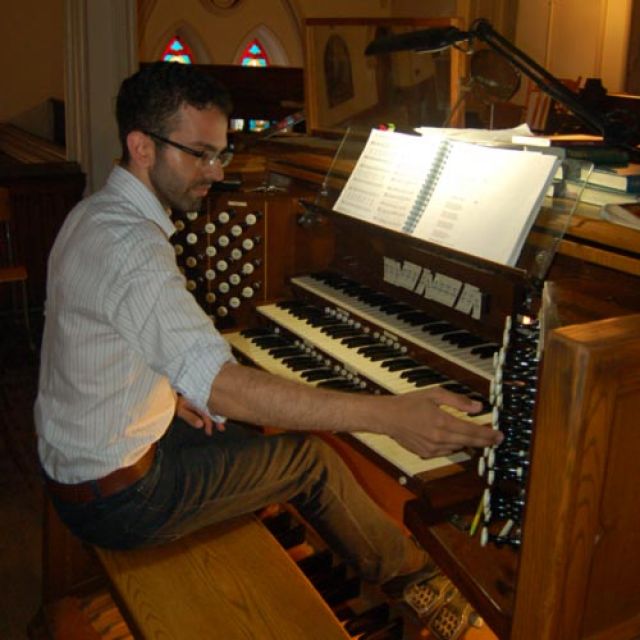TORONTO - For an organist, preserving an instrument’s sound is like maintaining a relationship. It calls for strict attention to atmosphere, communication and a whole lot of listening.
“You try as hard as possible to keep the air in the church as consistent as possible,” said John Paul Farahat, organist at St. Basil’s Church in downtown Toronto. “When you have changes in humidity, when you have changes in temperature, it really affects the pipes because they are all either made of wood or some combina tion of metals.”
In Grade 12, after playing the piano since childhood, Farahat began studying the organ. Now pursuing a masters of music and performance at the University of Toronto, Farahat, 23, has worked with the National Catholic Broadcasting Council’s Daily Mass since 2007.
Farahat took over as the principal organist at St. Basil’s in May 2011, meaning his relationship with the church’s 93-year-old pipe organ had officially become serious.
“What essentially I try to do as the principal organist here is try to maintain it,” said Farahat. “One of the things an organist can do, when you have a pipe organ, is you always make sure, first and foremost, that those expressive pedals are in an open position so that the shutters are opened. Gradual (temperature) changes ... have far less of an effect on how far the instrument goes out of tune.”
This allows air to flow freely around the pipes ensuring that when the temperature inevitably changes in the church it also changes in the boxes that enclose selected pipes.
During the summer months Farahat admits efforts to ensure a constant temperature are often in vain, though it hasn’t discouraged him from trying.
“In a church like this where there is no air conditioning, in the summer you are kind of at the mercy of the weather and the most you can do is just open the windows and hope for the best,” said Farahat. “In the winter (the University of St. Michael’s College’s) heating system is what runs this church and so you have a certain degree of control over the heat.”
But keeping things comfortable is only part of the equation. Like any relationship, the key to preserving an organ’s sound is communication.
“The second way to maintain it, really, it’s the one thing I know a lot of organists have, is a log book (to) record whenever you find something wrong,” said Farahat. “So when the maintenance crew comes in the next time, they look at this book. They don’t look at the organ and say what’s wrong because they would never get the job done... you essentially point them in the right direction.”
Farahat also goes through every note in every stop regularly — at least once between the three to four annual maintenance services.
It’s a practice veteran organ technician Robert Hiller encourages organists to do.
“It’s very important to have more detailed instructions (because it takes) less time to find the problem,” said Hiller, of Alan T. Jackson & Company, which has maintenance contracts for more than 200 organs, including St. Basil’s. “If it is only misfiring the odd time it is difficult to find where the problem is until it happens right in front of your eyes. Sometimes it is just a certain combination of stops that makes the problem happen.”
At an average cost of $500 per fourto five-hour visit, keeping troubleshooting short and sweet is the aim of the game. While many parishes, such as St. Basil’s, hold fixed rate contracts, it is those that try to scrimp and save who often lose out.
“If we don’t go regularly then the list of troubles will take more time and you are spending more money,” said Hiller. “If you don’t maintain your organ regularly, if you are someone who calls only the odd time, then you won’t get that kind of service. We’ll have to bill by the hour.”
St. Peter’s Church on Bathurst Street is a parish without a maintenance contract and it shows. Built in 1927, the open concept church was acoustically designed to maximize the potential of the organ, which has since taken a turn for the worse.
“The organ has been here since the church was built in 1927 and the organ has been very much a part of our tradition,” said Fr. Jim Haley.
“We would love to have it up to par.”
It’s a matter of dollars and cents which prevents the much needed restoration — not to mention a tuning.
“If I had some extra money I would gladly put it into the organ to see if we could build it up,” said Haley. “Right now we have some other priorities in the parish that we have to attend to.”
This is the story for many parishes where a once enchantingly booming organ now screeches off key, if it makes any noise at all. Hiller said full restorations of traditional electro-pneumatic organs, which often means converting them to digital-console organs, costs between $50,000 to $150,000.


